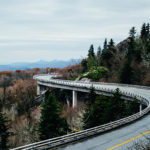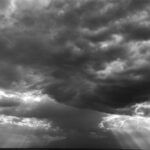You might be wondering how the beautiful landscape photographs shown in magazines are shot. The colors are so vibrant and the compositions are always interesting, the way they guide your view from the foreground to a main subject to the background. Everything is sharp in focus.
How do they do that?
Let’s assume you want to take a photograph of a mountain range with meadows covered with flowers. Some objects are close to you, in the foreground. Other objects are farther away in the midground and the mountains and the sky are at a distance, serving as background.
In order to keep all this in focus, you need lots of depth of field. This can be achieved by selecting a small aperture like f16 or f22. At the same time, you want the photograph to have as much detail and as little graininess (with film) or as little noise (with digital) as possible. That’s why you select a low ISO (film) or ISO setting (digital). Low ISO settings will give you the best quality, but at the expense of slow shutter speeds. Your shutter speed will most likely be slow for handheld shots. That’s especially true if you want to take your photographs in early morning or late afternoon light. Using a tripod is highly recommended.
Most of us, myself included, take the time on weekends to relax. After getting up at 8 am or later, it takes awhile to get cleaned up. Then we tend to have a nice breakfast. By the time we are ready to go anywhere to take photographs, it is about 10 am or later. Unfortunately, by that time, the light is no longer favorable. Taking photographs at this time will result in average-looking pictures with dull colors.
If you want the bright colors, enhanced by interesting lighting, you need to be up and ready with your camera starting right at sunrise. You’ll then have two to three hours to take photographs in the best light. After this time, you can take a break, until two to three hours prior to sunset. At these times,the light is interesting and gives warmth to the colors. Changing the daily routine will give you better opportunities for taking great landscape photographs. That’s why I think an alarm clock is a very useful tool for the landscape photographer.
Lighting is an important factor, but so is composition. Returning to our project, we have this majestic mountain range in front of us. The mountains are in the distance, making the background. If they were closer, they would not fit in the frame. There is the meadow with the flowers in front of the mountain range. The closest object is a tree, which I will use to frame one side of the image, and it serves as the foreground.
Then there is the bright blue sky to think about. What to do with it? Since I want to emphasize the meadow and the mountains, I’ll leave a narrow strip for the sky, approximately one third or less of the top image area. If the sky had interesting cloud formations, I may have chosen to fill two thirds or a little more of the upper area with sky.
Avoid having the sky and landscape each take half of your photo. In other words: don’t have the horizon run right through the middle. Imagine your image is divided into nine equal rectangles. It’s as if you are looking at a checkerboard of three rows across, three rows down, resulting in nine rectangles (not squares). Try to place objects of interest into any of the four points where the lines intersect. Avoid placing the main object in the center rectangle.
Practice following these guidelines and your images will become better and better. As you practice, you may find yourself making these visual choices naturally. Good luck!
About the Author:
Andreas Salomon has been a landscape photographer for over 20 years (andysalomonphotography.com). “I was first bitten by the photography bug through my lifelong fascination with nature.”
Like This Article?
Don't Miss The Next One!
Join over 100,000 photographers of all experience levels who receive our free photography tips and articles to stay current:








Here’s a *don’t* for landscapes: Don’t over-process or try to “HDR” one to death. Ugh.
In my experience f22 is rarely a good f-stop because it is far from the sweet spot of the lens.
F11-13 should suffice. Else, if on a tripod, try focus stacking.